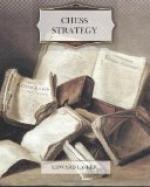His combinations will become more and more sound, he will learn to value his forces more correctly, and therefore to husband his pieces and even his pawns with greater care. In this second stage his strength will increase steadily, but, and this is the drawback, only as far as his power of combination is concerned. Unless a player be exceptionally gifted, he will only learn after years of practice, if at all, what may be termed “positional play.” For that, it is necessary to know how to open a game so as to lay the foundation for a favourable middle game, and how to treat a middle game, without losing sight of the possibilities of the end-game. It is hopeless to try to memorise the various openings which analysis have proved correct, for this empirical method fails as soon as the opponent swerves from the recognised lines of play. One must learn to recognise the characteristics of sound play. They apply to all and any position, and the underlying principles must be propounded in a manner generally applicable. And this brings me to the substance of my subject, round which I will endeavour to build up a system compatible with common sense and logic.
Before I proceed to develop my theme, I shall set down a number of elementary rules which will facilitate the understanding of such simple combinations as occur at every step in chess.
If we ignore the comparatively small proportion of games in which the mating of the opponent’s King is accomplished on a full board, we can describe a normal, average game of chess in the following way. Both sides will employ their available forces more or less advantageously to execute attacking and defensive manoeuvres which should gradually lead to exchanges. If one side or the other emerges from the conflict with some material gain, it will generally be possible to force a mate in the end-game, whilst if both sides have succeeded by careful play to preserve equality of material, a draw will generally ensue.
It will be found a little later that a single pawn may suffice, with some few exceptions, to achieve a victory, and we shall adopt the following leading principle for all combinations, viz. loss of material must be avoided, even if only a pawn. It is a good habit to look upon every pawn as a prospective Queen. This has a sobering influence on premature and impetuous plans of attack.
On the other hand, victory is often brought about by a timely sacrifice of material.
But in such cases the sacrificing of material has its compensation in some particular advantage of position. As principles of position are difficult for beginners to grasp, I propose to defer their consideration for the present and to devote my attention first to such combinations as involve questions of material. Let us master a simple device that makes most combinations easy both for attack and defence. It amounts merely to a matter of elementary arithmetic, and if the beginner neglects it, he will soon be at a material disadvantage.




